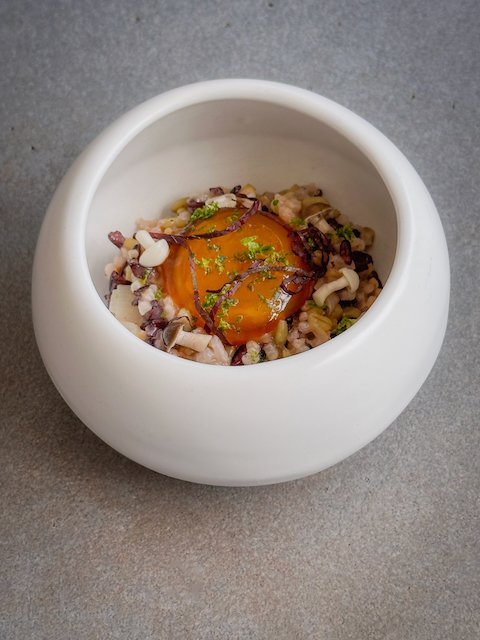A Simple Bowl of Grains
We discussed this dish for months before serving it. The goal was to elevate a simple bowl of grains, something we might look past in the culinary world in favor of showier things and yet is a staple in homes everywhere.
The first night we served it, I admit to having a small crisis of confidence. We put our hearts into everything we do at L’Ostrica, but this is one of those dishes that summarizes our philosophy and our journey better than our descriptions ever could. I worried that people would just see a bowl of cereal. Relief set in quickly, though, as I heard the sounds of spoons traveling along the curves of the bowls, over and over, until the bowls were emptied.
Hearing that happy clanking of spoon-against-bowl night after night has been nothing short of uplifting. That tiny sound, mingled seamlessly with lively conversations at the table, is a gentle reminder for Eric and me of why we do what we do.
We only get so long at the table to share everything that goes into each dish we serve. The ingredients we choose. The techniques we employ. The refinements we make. The many hands that play a part in its existence. The wine we pour to make it even more compelling. I’ve been thinking it would be nice to share some more details about this dish and, in future posts, others.
So, let’s start off small and see where it takes us…
We started with three grains from Anson Mills, each selected for their own unique characteristics and history.
The farro verde, an emmer whose name speaks to its soft green hue, was selected for its rich, hearty texture. Farro traveled from the Fertile Crescent to Italy and has been cultivated for 10,000 years. We’ve been farming for about 12,000.
On the other side of the spectrum are the rice middlins. Delicate yet strong, they hide a faint sweetness in their core. These broken pieces of Carolina Gold rice were once deemed not good enough for export. So, they stayed here in the Carolinas, becoming integral to dishes made by skilled West African cooks who took note of their positive qualities—long before restaurant chefs took interest. I love them in my shrimp and grits and with anything saucy, but I would also happily eat them with a little butter and salt. They’re just that perfect.
In the middle is the Tiara Purple, an ancient rice from Asia that was once reserved for emperors. Highly aromatic, it fills the kitchen and dining room with its nutty, floral character when cooking, and it almost pops in the mouth when eaten. The compounds that make it purple are the same found in other, similarly colored superfoods. In other words, this rice is good for you.
After cooking each of these separately, we toss them in a vinaigrette made with doenjang, an umami powerhouse used heavily in Korean cooking. Think of it as a more potent miso. It is bold and long-lasting (and the base of my favorite soup of all-time, but that is a post for another day.)
To this rice mixture, we add local spring onion that has been grilled on the binchotan until the inner layers are meltingly tender. The onions become sweet this way, and carry a faint wisp of smoke. To add richness and even more flavor, we ladle a soy-cured egg yolk on top. Besides being luscious, the yolk binds everything together, so the eater doesn’t have to chase the kernels of grains around. And then we finish with shisho leaf, pickled baby bunapi mushrooms, and lime zest; their freshness is a counterweight, providing brightness and balance.
All of this comes together in a cozy rice bowl whose rim folds gently inward, concentrating the aromas like a wine glass, holding in the warmth, and almost hiding the many tiny treasures within until the diner dives with a spoon in and discovers them.

